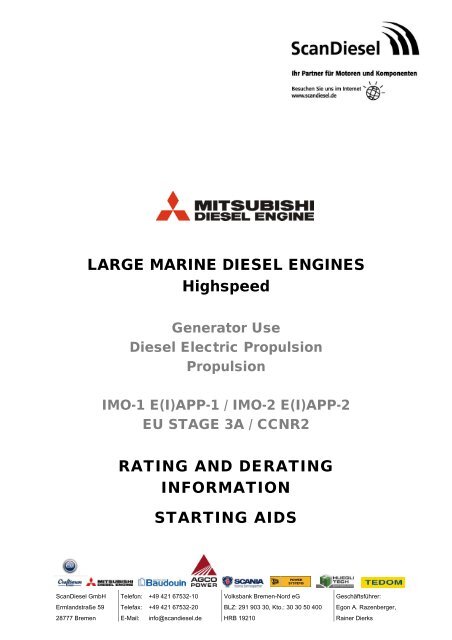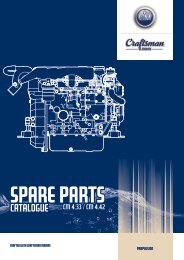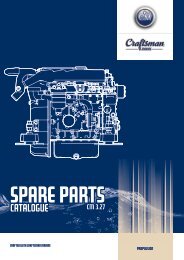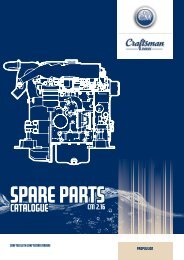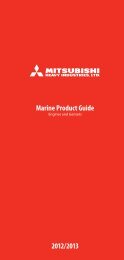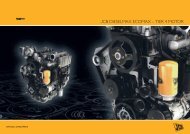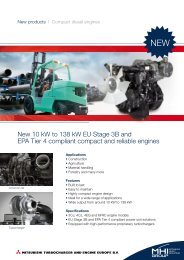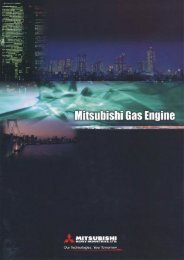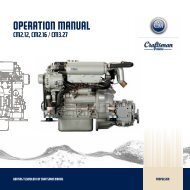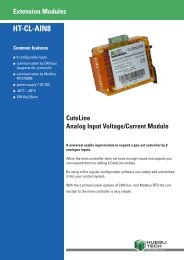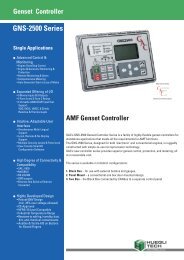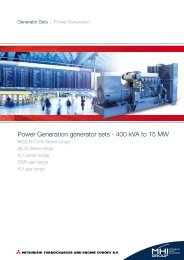Rating and Derating for Mitsubishi Marine Engines - ScanDiesel ...
Rating and Derating for Mitsubishi Marine Engines - ScanDiesel ...
Rating and Derating for Mitsubishi Marine Engines - ScanDiesel ...
- No tags were found...
Create successful ePaper yourself
Turn your PDF publications into a flip-book with our unique Google optimized e-Paper software.
<strong>Rating</strong> Definitions <strong>for</strong> <strong>Marine</strong> Power GenerationSymbol&Ratio <strong>for</strong>Output<strong>Rating</strong> Overload DefinitionLimitedRunningTime+10%Applicable <strong>for</strong> supplying continuouspower paralleled with the utility <strong>for</strong>the limited short-time period.AllowableAverage LoadFactor <strong>for</strong> 24Hours100% of RatedPowerOver-Load of110% can be used<strong>for</strong> less than 25hrsper year onemergency.80% of RatedPowerTypical OperationYearlyAverageLoad FactorLess than100%YearlyOperatingHoursLess than500HrTypical OverhaulIntervalTopComplete1000HrApplicationSeasonal PeakCutSt<strong>and</strong>-by PowerSourcePPrimeUnlimitedRunningTime+10%Applicable <strong>for</strong> supplying power withvarying load instead of the utility <strong>for</strong>an unlimited time.100% of RatedPower is availableintermittently <strong>for</strong>3Hr per every24Hr operation.Over-Load of110% can be used<strong>for</strong> less than 25hrsper year onemergency.100% of RatedPowerLess than60%Unlimited8000through12000HrSt<strong>and</strong> alonePower SourceDaily Peak CutPower Source <strong>for</strong>ConstructionC Continuous +10%Applicable <strong>for</strong> supplying powercontinuously paralleled with theutility.Note: Diesel-electric drive installation is not included in this rating definition.Over-Load of110% can be used<strong>for</strong> less than 25hrsper year onemergency.Less than100%Unlimited 4000Hr 8000HrBase Load paralleled with theutilityT0102-0002E Rev.2 (3/3)
J.. MITSUBISHI DIESEL ENGINE ITEM NO. T0109-0001E (114)TECHNICAL INFORMATION DATE Oct., 2012STARTING AIDS1. GeneralThe ease with which a cold diesel engine can be started up is dependent largely but not solely on thetemperature of ambient air. This is more so with diesel engines, whose fuel is ignited <strong>and</strong> burned by the highair temperature produced by compression.In a cold diesel engine, its cold cylinder walls rapidly take heat from the compressed air during the initialengine cranking period. Moreover, its lube oil is far more viscous, making the crankshaft harder to turn.Intake air, if low in temperature, may not easily reach that high temperature level on each compression strokewhich is <strong>for</strong> sure <strong>and</strong> positive ignition to overcome the increased resistance of the engine's running parts. Incold weather, the battery is slightly down in its capacity. All these lead to "hard cranking," causing thestarting motor to draw more energy from the already weakened battery.Starting aids refer to methods <strong>and</strong> devices calculated to ease those factors of "hard cranking" under thespecified low-temperature conditions to be normally encountered by the engine.One such device is the jacket water heater. By heating the jacket water, it warms up the areas aroundcombustion chambers so that, upon firing up, the engine can be quickly made ready to take up load.2. Low-temperature specification of fuel, lubricating oil <strong>and</strong> coolantFor the purpose of specifying the types of fuel, oil <strong>and</strong> coolant <strong>for</strong> diesel engines to be used under lowtemperatureconditions, the range of ambient air temperature, from -1 OCC up to 5 c C is divided into three subranges;these liquids <strong>and</strong> the battery as items of low-temperature specification are prescribed <strong>for</strong> each subrange,as follows:Die s el fuel oilLubricating oilItemAmbient temperature COG)_10° to _5° I _5° to 0° 0° to 5°ASTM D 975 No. 2-DBS 2869 Clas s AMHI IFM No. T 54-0020-ERemarksC etane index of45 or moreSAE* lOW SAE * 30 * Society ofAutomotivexOr, alternatively, multi-grade SAE * 15W-40Engineers, Inc.* NationalLubricating grease NWI * No. 0 orNo. 1 NWI *No.2 LubricatingOre as e InstituteBattety Cold-temp. typeISt<strong>and</strong>ard typeThis data updated T67-0050-E rev.2<strong>and</strong> newly acquired the ITEM NO.:::I...... 0r/l.~~First Edition: Oct., 2012Engine Engineering DepartmentEngine System Designing SectionApproved by Checked by Drawn byT.HASHIGUCHI T.OGURAK.N• MITSUBISHI HEAVY INDUSTRIES, LTD.~ GENERAL MACHINERY & SPECIAL VEHICLE
, ITEM NO. , T0109-0001E (2/4)3. Starting-aid devices <strong>and</strong> methods availableSt<strong>and</strong>ard devices <strong>and</strong> methods of starting aid are as follows:D evic e or metho d Purpose DescriptionTo reduce the resistance, which is high The heater is to be put in the oil pan. ItsOil pan heaterb ecaus e 0 f c old lubricating oil, 0 f the rurming heating action follows the jacket water heaterparts to start-up cranking action.in contro1.Jacket water heaterTo keep cylinder liners warm in a cold engine,so that the engine can be started more easily<strong>and</strong> quickly made ready to take up load.It prevents damage to engine due to coolantfreezing.This heater is inserted into a lower section ofthe coolant path to promote convection flow.Its heating action is controlled.Lub e oil priming1) Periodical priming2) Start-up primingStart-up idling(low idling)To protect the bearings against loss oflubrication at the time of sudden enginestarting or loading.To prevent the bearings from losinglubricating films 0 f oil at c old engine starting.1) This method uses a motor-driven oilpump <strong>and</strong> a timer.(Example) Priming is to be per<strong>for</strong>med <strong>for</strong>5 minutes at intervals of 6 hours while theengine is being shut down.2) This method uses a motor-driven oilpump or an air booster (in case ofanair-start engine).(Example) Priming is to be per<strong>for</strong>med <strong>for</strong>a given p erio d 0 f time prior to start-upcranking of a cold engine.Idling run (at 112 the rated speed) is toimmediately follow firing up 0 f a c old engine.P.ir heaterThis device is fitted to the inlet manifold. It isTo raise the temperature of intake air in order turned on <strong>for</strong> about 20 to 60 seconds prior toto facilitate fuel ignition.start-up cranking. Available engines equippedwith a manually starter.• MITSUBISHI HEAVY INDUSTRIES, LTD ...... GENERAL MACHINERY & SPECIAL VEHICLE
4. Starting aids <strong>for</strong> engines arranged to start up automaticallyI ITEM NO. , TOI09-0001E (3/4)Starting aids are selectively used on automatically starting engines according to the startingtime specification, as shown in this chart:St<strong>and</strong>ard starting aid chartStaring time 10 seconds 20 seconds 40 secondsAmbient temp., °C _100 to _50 _5 0 10 +5 0 Above +50 _10 0 10 _50 _5 0 10 +50 Above +5 0 _10 0 10 -SO _50 10 +SOOil pan healer 0 - 0 - 0 0Above +50-SIartingaidJ ackel water healer 0 0 0 0 0 0ProhibitionProhibitionLube oil priming(inlermittenl)0 *10 0 *10 - -SIart-up idling device - - 0 *10 0 0*2 0-*10El\ginemodelS 12R-2,S 16R-2 Prohibition Prohibition 0 0 0 0Olher modelsS12R-2,S16R-2 0 0 0 Prohibition 0 0 0 0are excluded.00*1: For "V" <strong>and</strong> other non-in-line engines*2: Only S12R-2 <strong>and</strong> S16R-2 are applied.NOTES:1) Unless otherwise specified, all engines are subjected to maintenance run <strong>for</strong> 5 to 10 minutes weekly.2) "Lube oil priming" <strong>and</strong> "start-up idling" need not be per<strong>for</strong>med on L-6 engines (smaller than S6R2) onwhich maintenance run would be surely per<strong>for</strong>med. (mark * 1)3) The starting aids shown above are <strong>for</strong> the st<strong>and</strong>ard devices <strong>for</strong> electric start engines <strong>and</strong> are subject tochange according to actual engine application.4) The cetane index of fuel oil to be used should be higher than 45. If fuel oil having a cetane index lessthan 45 (<strong>for</strong> instance: 40 up to 45) would be used unwillingly, the following treatments should be applied<strong>and</strong> the contact to <strong>Mitsubishi</strong> Heavy Industries, Ltd. should be required <strong>for</strong> instruction.a) Install a jacket water heater.b) Ambient temperature should be:Above -5°e <strong>for</strong> 40-second starting timeAbove +5°e <strong>for</strong> lO-second starting time5) Install a jacket water heater in case of an air-start engine.6) S12R-2 <strong>and</strong> SI6R-2, the 1O-second starting time is prohibition.S12R-2 <strong>and</strong> SI6R-2, the jacket water heater should be installed 20-second <strong>and</strong> 40-secondstarting times <strong>and</strong> is not concerned with ambient temperature. (mark *2)• MITSUBISHI HEAVY INDUSTRIES, LTD ..... GENERAL MACHINERY & SPECIAL VEHICLE
ITEM NO. TOI09-0001E (4/4)5. Capacity <strong>and</strong> operating cycle data on starting aids(The in<strong>for</strong>mation <strong>for</strong> SU series engines are described on "SU circuit diagram")Starting aidOil pan heaterSt<strong>and</strong>ard capacity200-watt heater, one(<strong>for</strong> S6B , S6B3 , SM3 , S6R , S6R2 engines)2 OD-watt heater, two(<strong>for</strong> S12A2 , Sl2H engines)Typical cycle patternS·OO-watt heater,two(<strong>for</strong> S12R, S16R, S16R2 engines)TimeJacket water heaterl-kW heater, one(<strong>for</strong> S6B , S6B3, SM3 engines)2 -kW heater, one(<strong>for</strong> S6B , S6B3 , S6A3, S6R, S6R2 engines)Lube oil priming pump(p erio dical)2-kW heater, two(<strong>for</strong> S12A2 , Sl2H, Sl2R, S16R, S16R2engines)Pump drive motor:OAkW(<strong>for</strong> S6B, S6B3 , SM3 engines)0.7S kW(<strong>for</strong> S6R, S6R2, SUA2 engines)l.SkW(<strong>for</strong> S12H, SUR, S16R, S16R2 engines)Time6 hrs~ lE- 5 minStart-up idling device(the 10-second startingtime is outside an object.)Solenoid rating:24V - lSA100V - 4.SAr:;i.Idling,Starter-J,~Rated, rpmI \l ~ Firing-up detection• MITSUBISHI HEAVY INDUSTRIES, LTD.~ GENERAL MACHINERY & SPECIAL VEHICLE


